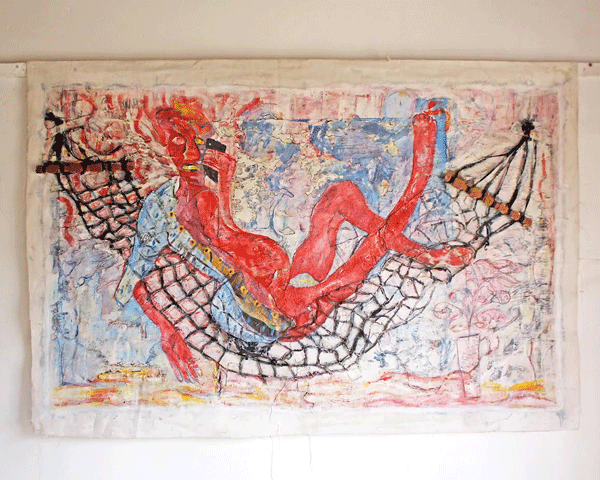
BY NYADZOMBE NYAMPENZA MANY Moods of Moses is the title for a recent exhibition in Chitungwiza that featured the work of three Masvingo-based artists.
The title is borrowed from the eponymously named album by Grammy award-winning Jamaica Dancehall deejay Moses Davis, popularly known as Beenie Man.
Both the sonic and the visual projects carry a similar ambition by employing diverse techniques and media to convey a varied tempo.
The three artists Anusa Salanje, Tafadzwa Finish and Bokorosi Sithole, who operate from Mwenezi, showcased their artefacts at the Many Moods of Moses exhibition.
Salanje showcased accomplished mixed media paintings on canvas, while Finish presented carefully crafted sculptures made out of found objects, and Sithole submitted welded art from scrap metal.
The three artists have other means of livelihood, which allows them to create without the burden of pandering to the market.
While Salanje is engaged in farming, Finish is a commercial photographer and Sithole is a welder by profession.
Salanjes’ canvases are populated with crowds of people in constricted spaces. Most of his subjects wear sad, agitated and despondent expressions.
- Chamisa under fire over US$120K donation
- Mavhunga puts DeMbare into Chibuku quarterfinals
- Pension funds bet on Cabora Bassa oilfields
- Councils defy govt fire tender directive
Keep Reading
As if to amplify their sombre moods, many have heads that are disproportionately larger than the rest of the body.
Several of the works are actually small portraits that invite close observation of the visage and the nuances in their facial expression.
Salanje picked the title for the exhibition and explained his choice, which was driven by his disdain for exhibitions that deal with a single theme.
“On every artwork there is a different story which might not be related to the other pieces in the exhibition. The moods differ everyday. The moods may be spiritual or physical,” Salanje said.
One artwork that bears witness to Salanje’s many moods is a piece that he calls Hammock, likely inspired by French artist Albert Gleizes’ Man in a Hammock (1913).
The work portrays a decadent scene, showing a potbellied semi-nude man reclined in a hammock and engaged on a cellphone.
The piece is in contrast to the emaciated folk in concentrated crowds depicted in his other works. Going by the idyllic scene and background of the ocean, the man appears to be on vacation at an exotic location.
Salanje seems to acknowledge that despite the doom and gloom narrative conveyed by his other works, not everyone in Zimbabwe is starving and suffering.
Finish’s small sculptures are characterised by their simplicity that is derived from his original materials.
Common objects such as tennis rackets, wire, bone and pipes are crafted into conceptually convincing figures of men and women posing individually or engaged in some social activity.
One of the pieces is a portrait of a masked face with emotive facial expression. Another piece which the artist says is inspired by a damsel from Masvingo is titled Tariro. It portrays a young woman in a body-hugging dress, a shy averted gaze and pursed ruby lips.
The subject’s dress is made from a black potato sack stretched over a tennis racket that is made to represent her curvy lower torso.
The arms are made from plastic tubes and the head is a flattened plastic container. Finish’s work demands the viewer to switch between subjective observation and suspension of disbelief.
It derives its charm from redeemed objects that may have previously served various functions and ultimately relegated to the trash heap.
Sithole is an utilitarian, who employs materials from his job as a welder. It is easy to imagine his creativity as a pastime connected to his daily grind.
It could also be his way of exorcising epiphanies that haunt his imagination whether sober or not, when he gazes at the bits of crap around him and they appear to embody a life of their own.
His pieces retain their rusted look, which maintains affinity to the junkyard from where they were retrieved.
The animated gestures of the pieces make the characters look as if they were frozen mid-motion. One is tossing a ball into an imaginary hoop and another is caught midstride while purposefully carrying a knapsack for spraying chemicals.
Sithole has the least number of pieces in the show and did not turn up as he was said to have gone to Chiredzi.
In all aspects, his involvement contributes a vital role of ensuring the art form is not minimised and marginalised.
The exhibition, which was hosted at Salanje and The Wailers Studio, is a great collaboration between artists from different regions.
In providing a platform for artists from a different town, the Studio abates competition and animosity between creatives in the visual arts sector.
- Follow us on Twitter @NewsDayZimbabwe







